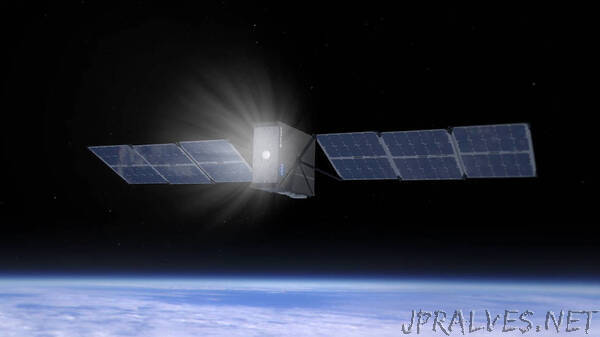
“A NASA CubeSat will launch into low-Earth orbit to demonstrate a new type of propulsion system. Carrying a pint of liquid water as fuel, the system will split the water into hydrogen and oxygen in space and burn them in a tiny rocket engine for thrust.
NASA’s Pathfinder Technology Demonstrator, or PTD, series of missions demonstrates novel CubeSat technologies in low-Earth orbit, providing significant enhancements to the performance of these small and effective spacecraft. The first mission of the series, PTD-1, is slated to launch this month aboard a SpaceX Falcon 9 rocket on the Transporter-1 mission from Cape Canaveral Space Force Station in Florida. In another project, NASA is also sending a swarm of three CubeSats, known as V-R3x, to demonstrate autonomous radio networking and navigation.
“We have a driving need for small spacecraft propulsion systems,” said David Mayer, PTD-1 project manager at NASA’s Ames Research Center in California’s Silicon Valley. “The need is for many reasons: to reach a destination, maintain orbit, maneuver around other objects in space, or hasten de-orbit, helping spacecraft at end-of-life, to be good stewards of an increasingly cluttered space environment.”
This addresses a major concern, as spacecraft can become orbital debris at the end of their missions. The longer defunct spacecraft stay in orbit, the greater chance of spacecraft-to-spacecraft collision, creating more debris.
Water as Fuel
The choice of fuel used in spacecraft propulsion systems can come with serious safety precautions. Traditional, high-performance fuels pose risks, including toxicity, flammability, and volatility. The use of such rocket fuels for in-space propulsion systems require extensive safety measures, and this drives up mission cost.
“To make these propulsion systems feasible for CubeSats, good propulsive performance needs to be balanced by safety,” said Mayer. “PTD-1 will meet this need with the first demonstration of a water-based electrolysis spacecraft propulsion system in space.”
PTD-1’s propulsion system will produce gas propellants – a mix of hydrogen and oxygen – from water, only when activated in orbit. The system applies an electric current through water to chemically separate water molecules into hydrogen and oxygen gases, in a process called electrolysis. The CubeSat’s solar arrays harness energy from the Sun to supply the electric power needed to operate the miniature electrolysis system.
These gases are more energetic fuels than water; burning hydrogen and oxygen gas in a rocket nozzle generates more thrust than using “unsplit” liquid water as propellant. This strikes a better balance between performance and safety for spacecraft propulsion, meaning CubeSats will get more bang for the buck.
“What’s new is that this system uses water as the fuel in an energetic way, with an inherently safe system,” said Mayer. “This mission will show that we can use water electrolysis in a rocket engine in space – that’s pretty cool.”
Water is an inexpensive “green” resource for propulsion, non-toxic and stable. Green propellants like water are easier to handle, cheaper to obtain, and safer to integrate into spacecraft.
“We are disallowed from using high-performance propulsion systems in CubeSats because of the nature of how we launch these missions, namely by being attached to other spacecraft,” said Mayer.
Most CubeSats and other small spacecraft launch to space as secondary payloads, often riding to space alongside larger and more expensive payloads. The use of traditional “high-performance” rocket fuels for CubeSat propulsion systems are avoided because the onboard presence of such fuels would increase mission risk to other payloads and the launch vehicle. The inability to use these fuels limits performance for small spacecraft propulsion systems.
“Water is the safest rocket fuel I know of,” said Mayer.
A Low-Cost, Effective Propulsion System
The PTD-1 spacecraft is a 6-unit CubeSat, comparable in size to a shoebox. Its flight demonstration, lasting four to six months, will verify propulsion performance through programmed changes in spacecraft velocity and altitude executed by the water-fueled thrusters. The mission will show that this safe, low-cost, high-performance propulsion system works in space and will pave the way for operational small spacecraft missions.
Flight qualification and demonstration of this technology increases small spacecraft mobility and capability for use in future science and exploration missions. This technology could be applied in future deep-space missions using water resources found off Earth such as from comets or the Moon and Mars.
The propulsion system, named Hydros, was developed by Tethers Unlimited, Inc., in Bothell, Washington. This technology was initially developed under a NASA Small Business Innovation Research contract and then matured under a NASA Tipping Point partnership. The PTD spacecraft bus was developed by Tyvak Nano-Satellite Systems, Inc., in Irvine, California. Tyvak is also performing payload integration and operations for the PTD-1 mission. Spaceflight Inc. of Seattle is providing integration and rideshare services for the PTD-1 spacecraft.
NASA’s Ames Research Center in California’s Silicon Valley manages the PTD series. NASA’s Glenn Research Center in Cleveland collaborates as the payload lead on the PTD-1 mission. The mission launches as part of NASA’s Educational Launch of Nanosatellites 35, provided by the CubeSat Launch Initiative, which is managed by NASA’s Human Exploration and Operations Mission Directorate. The PTD mission is managed and funded by the Small Spacecraft Technology program within the NASA’s Space Technology Mission Directorate.”
